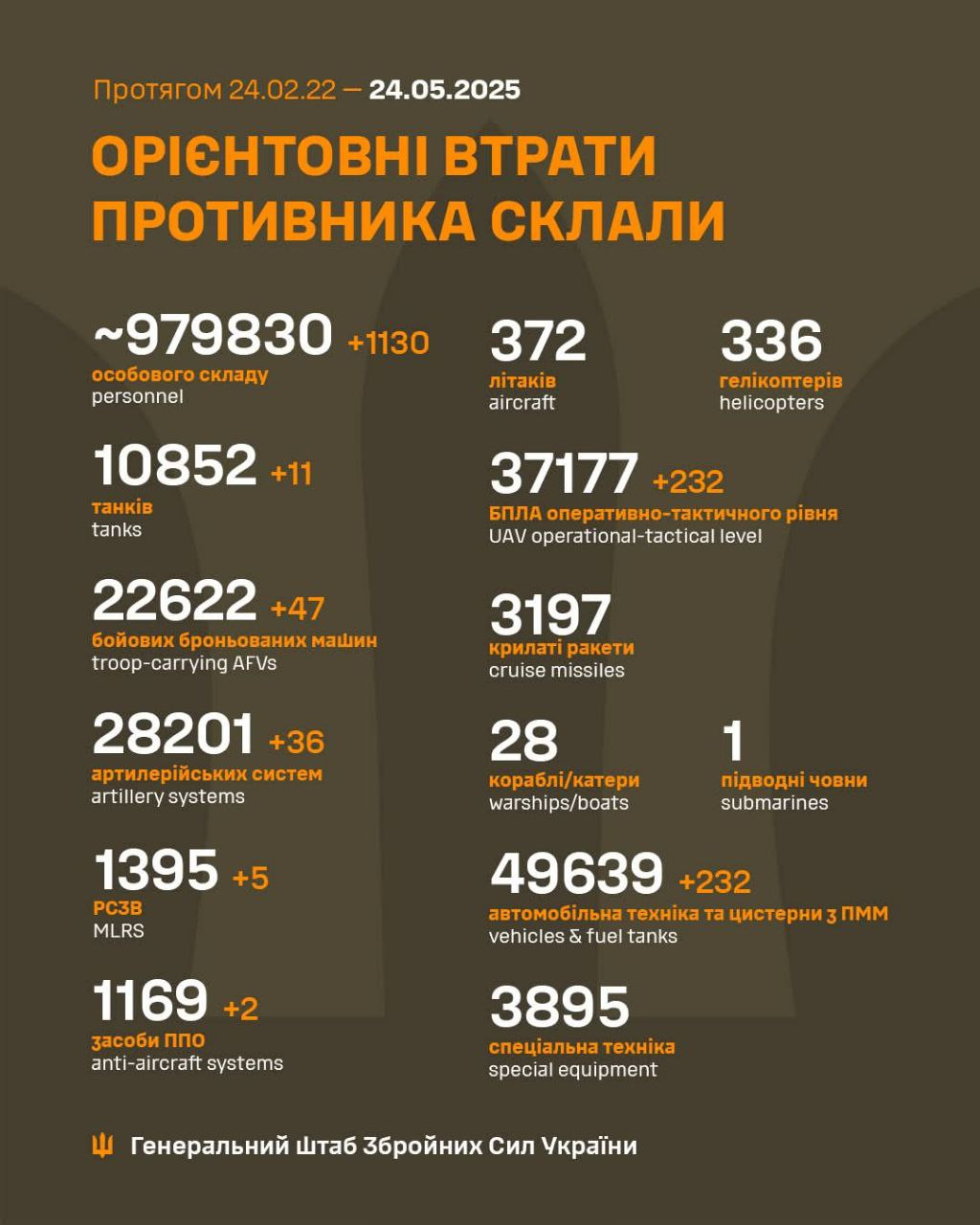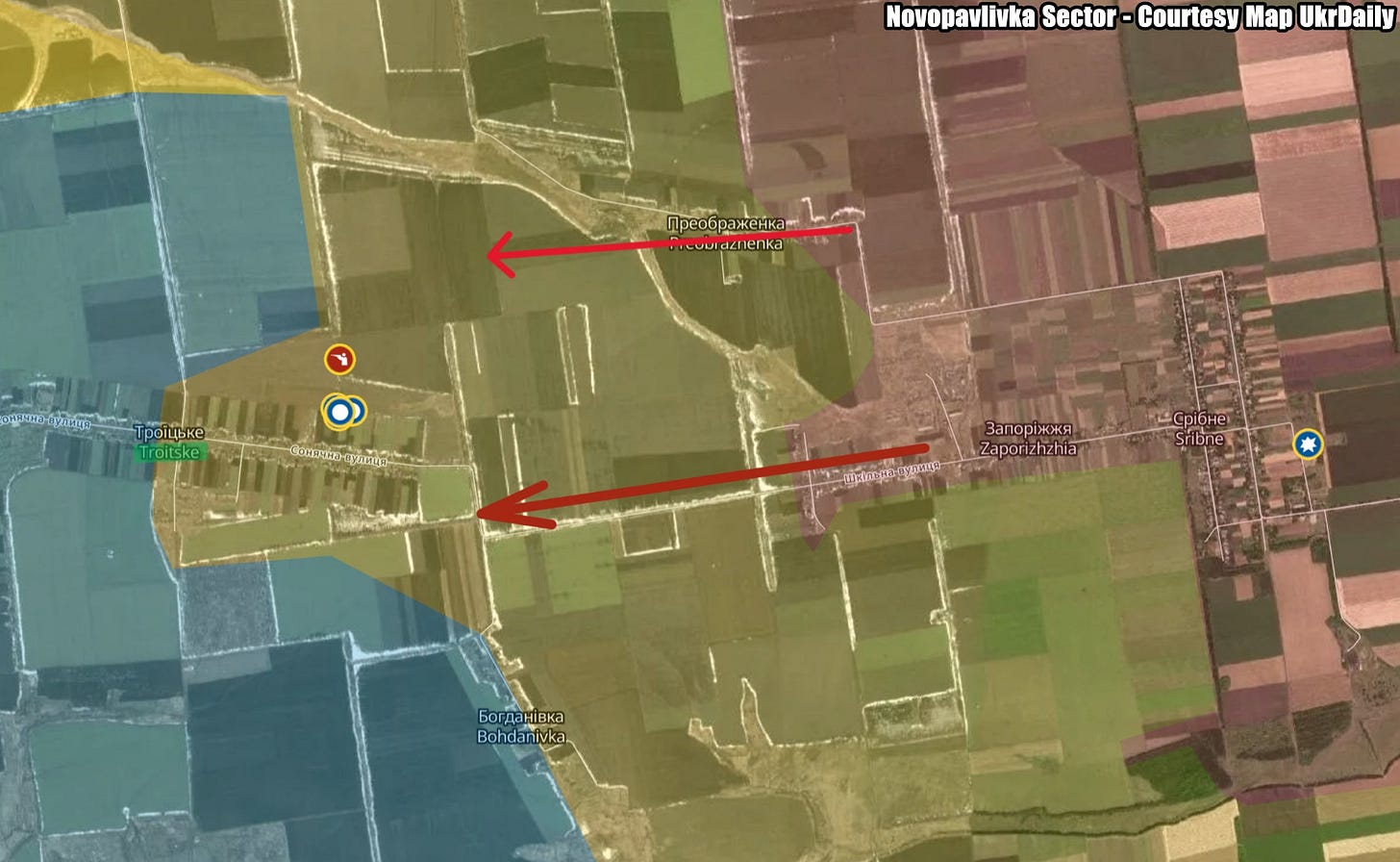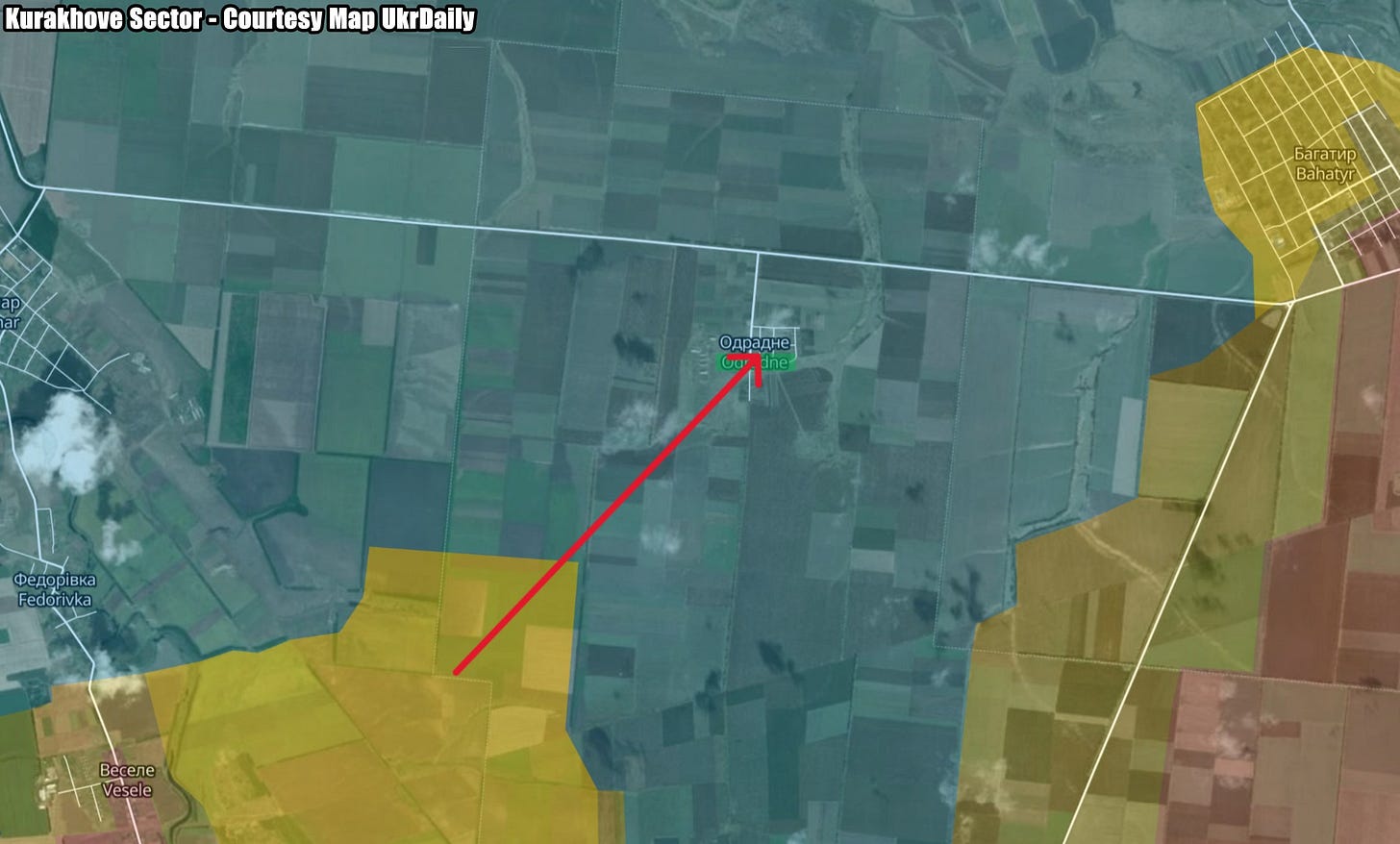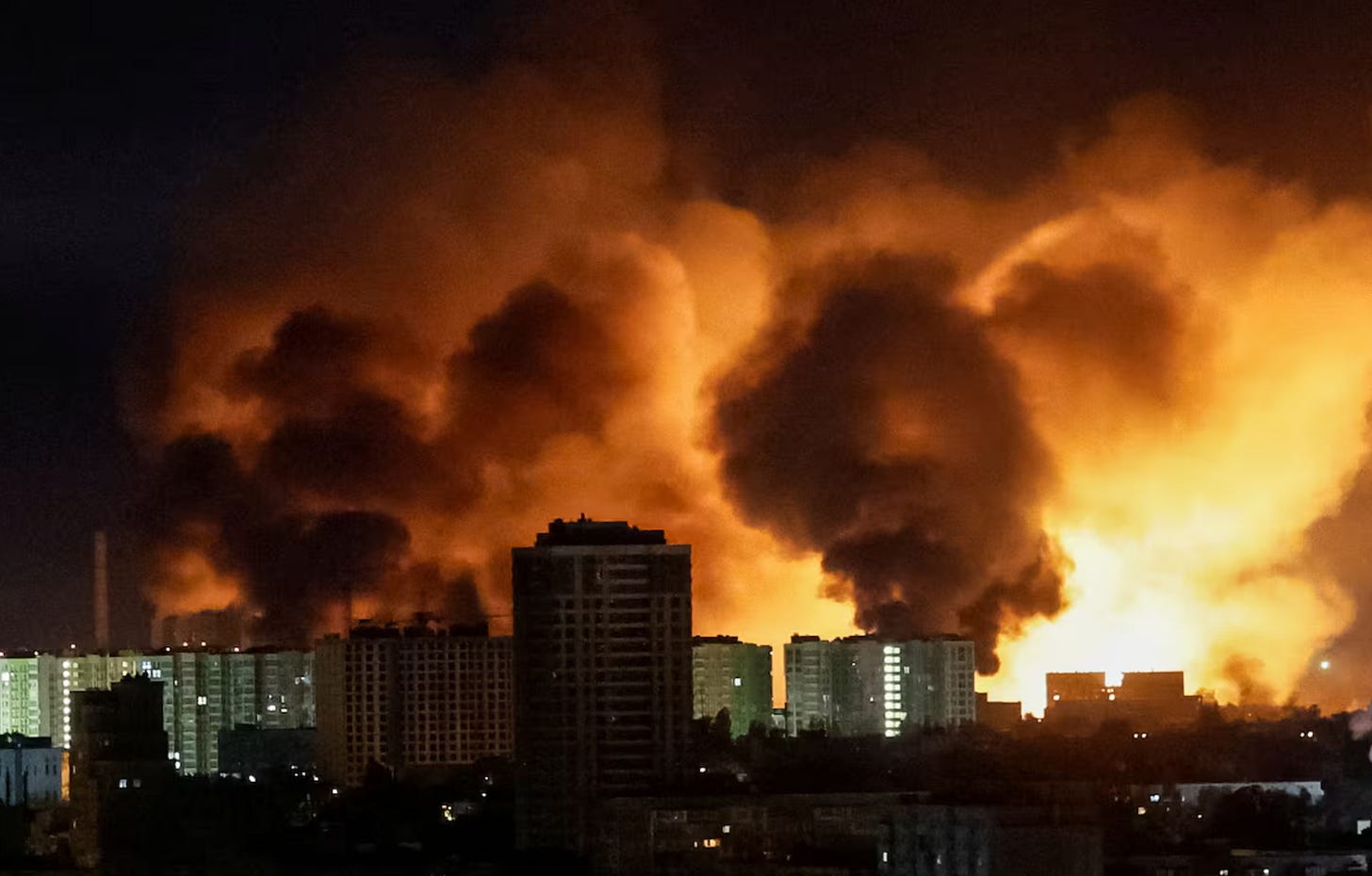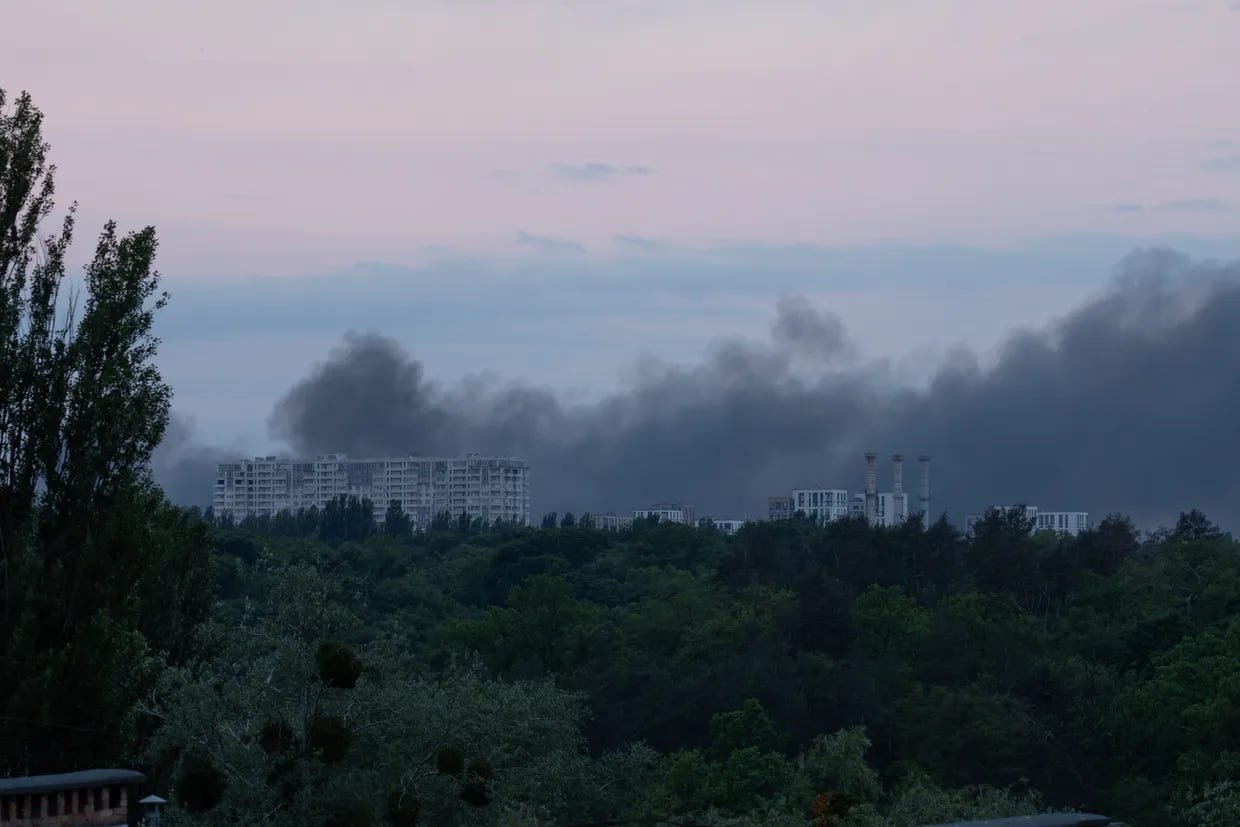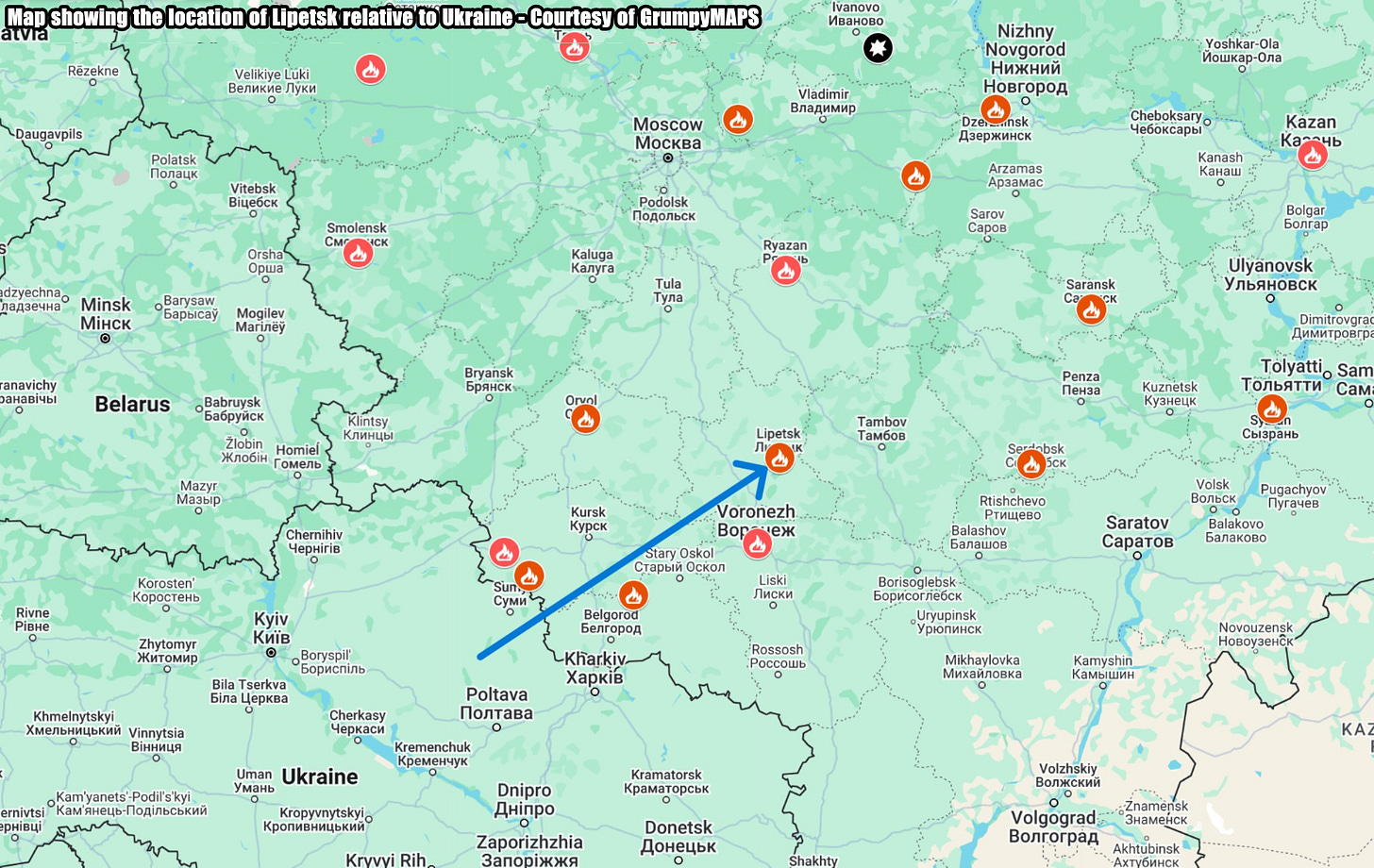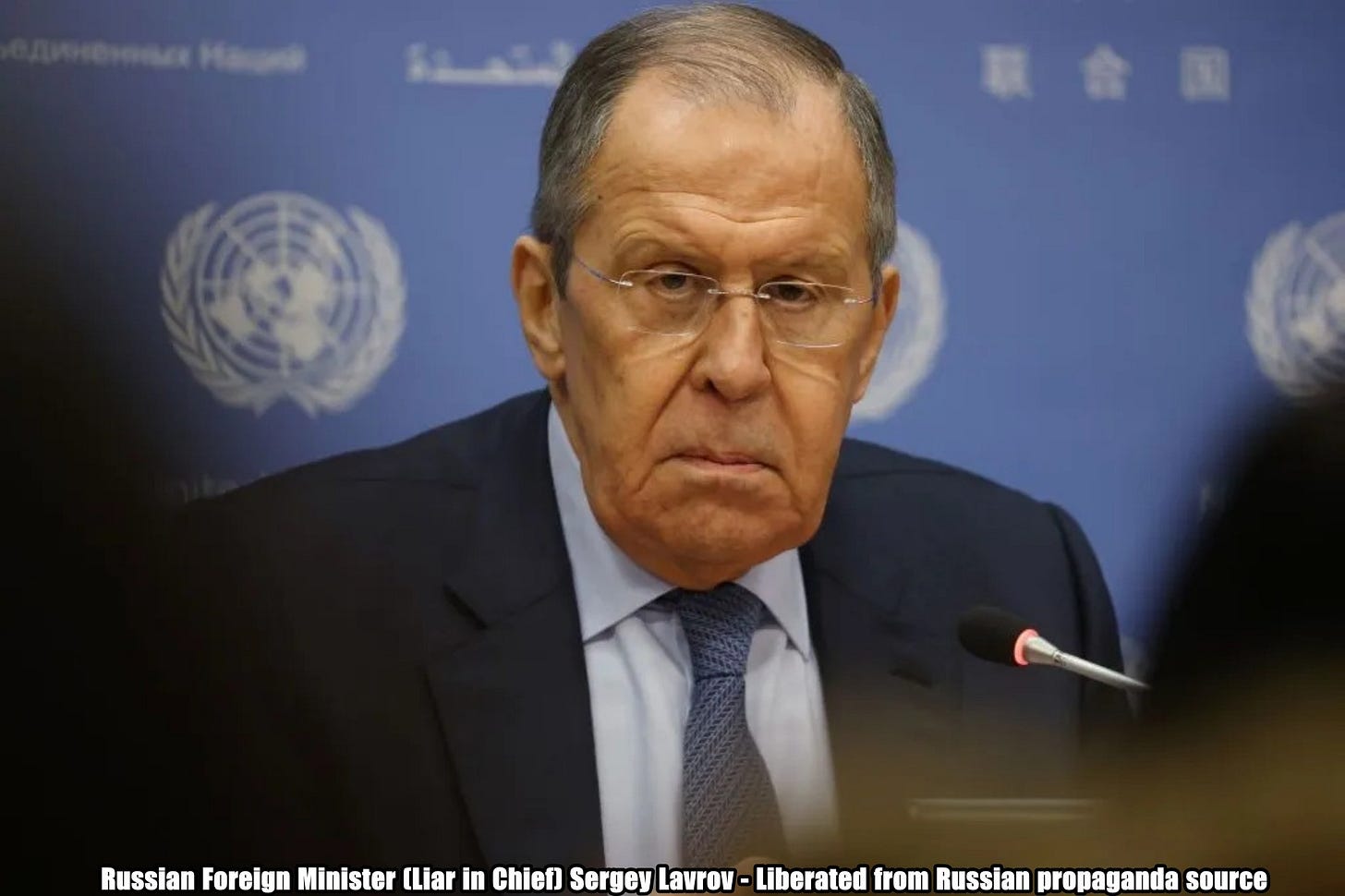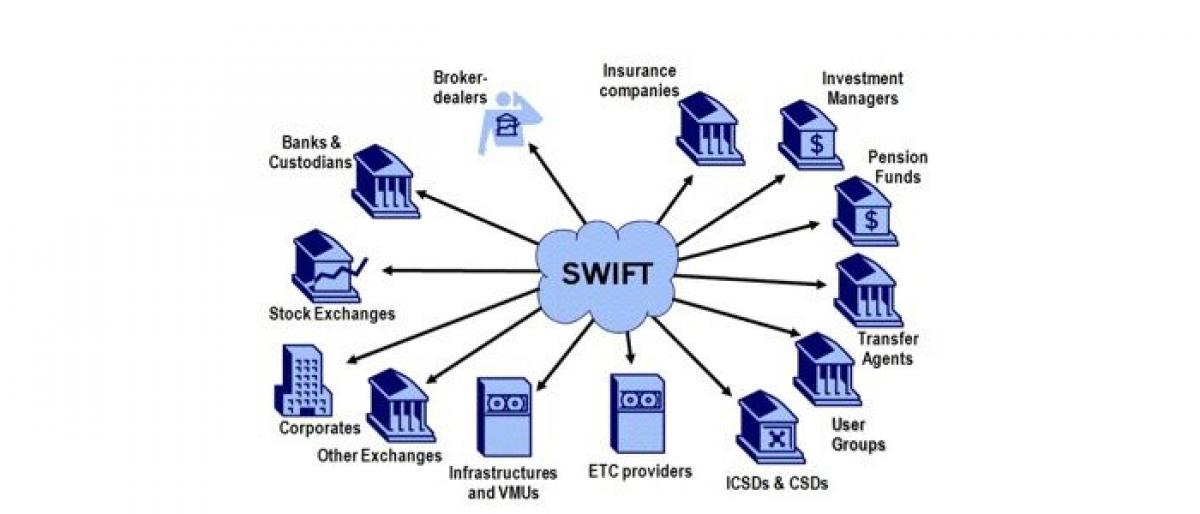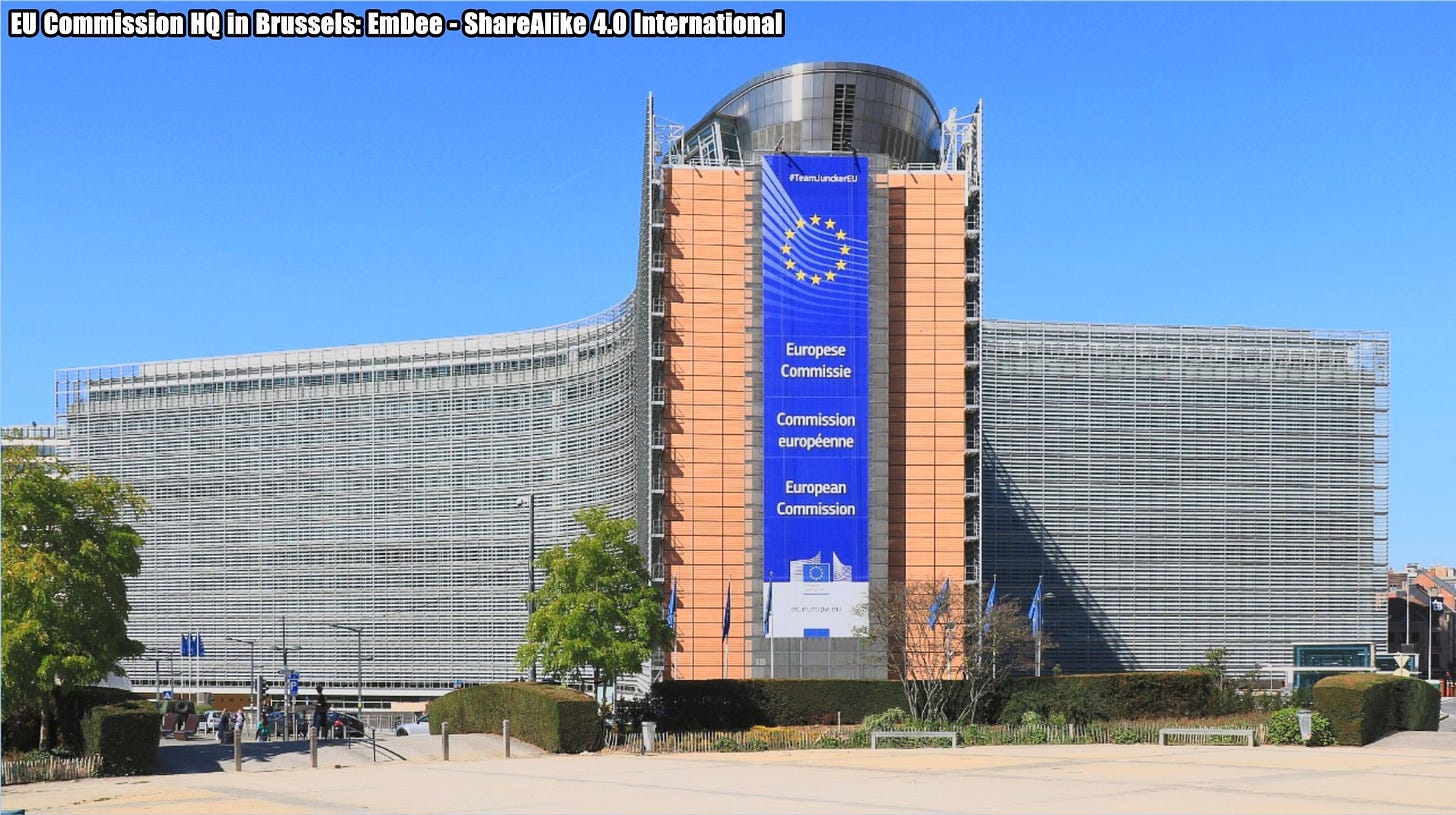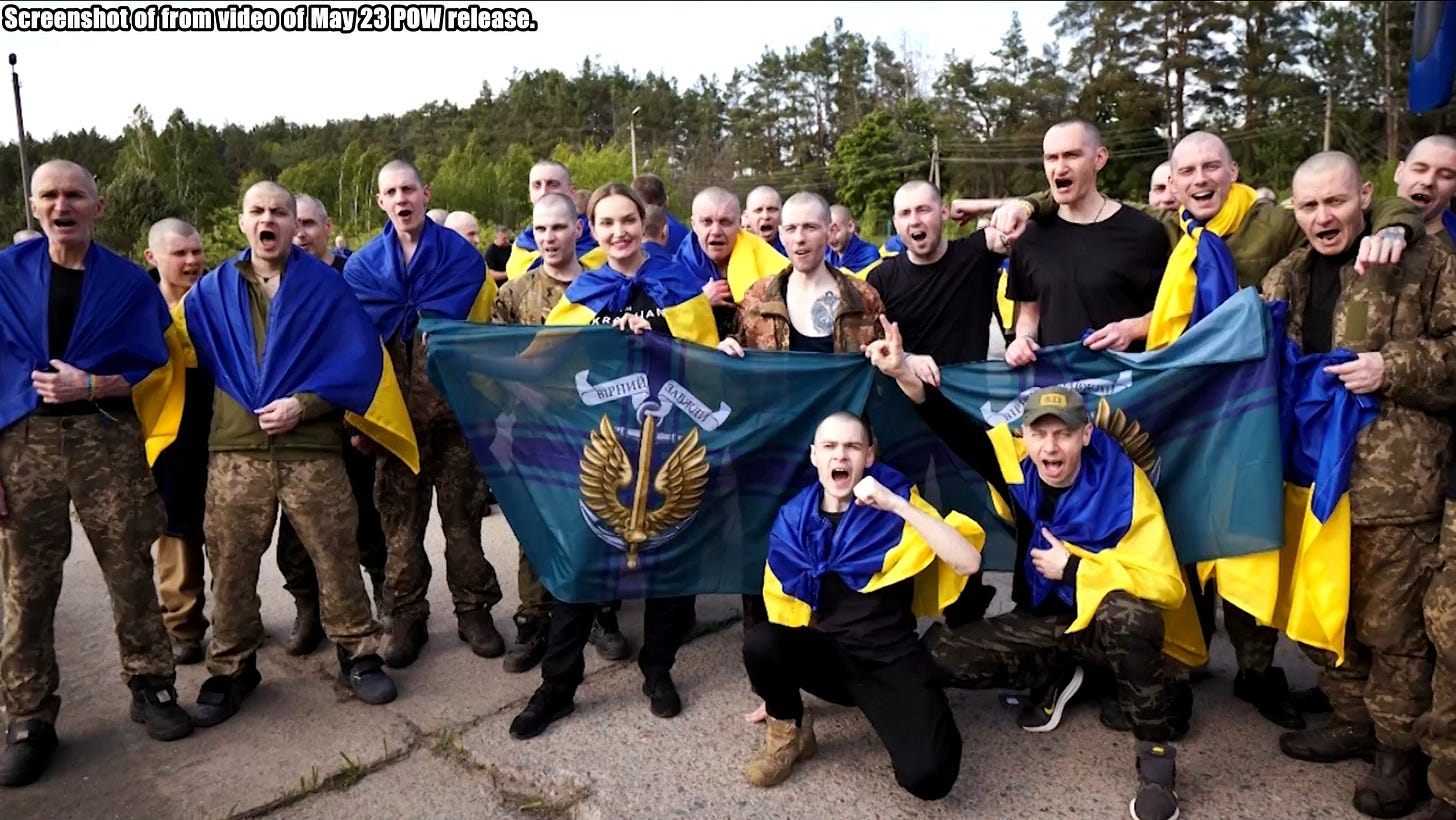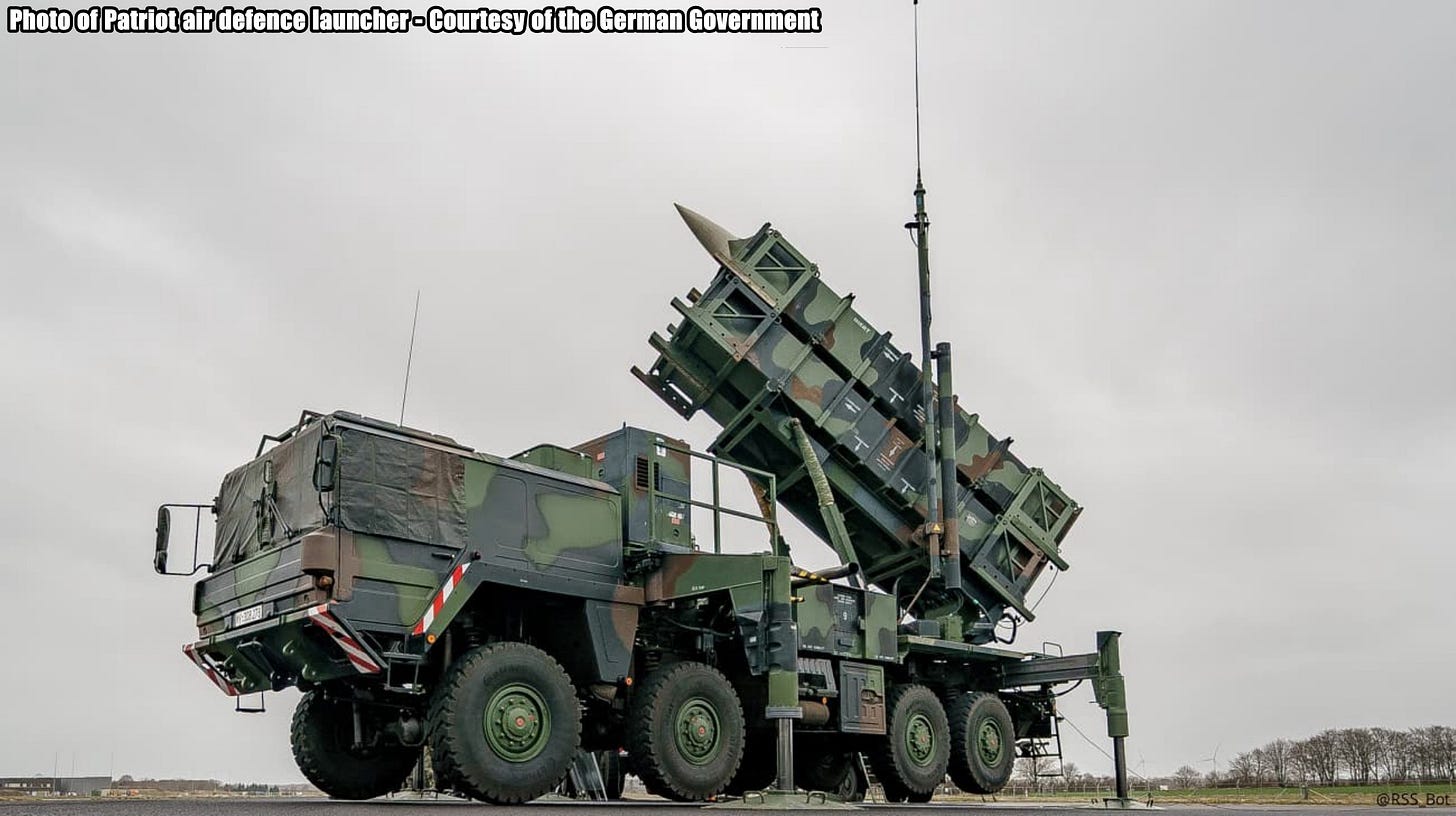Slava Ukraini! In early 2022 I began a Telegram channel aggregating news from a number of sources daily on the war in Ukraine. In June 2023 I began providing a daily draft for the Ukraine War Brief Podcast collecting news from over 70 sources daily, which formed the basis of the script. While the Podcast no longer exists I have continued to make this Brief available for my followers here on Substack for those who wish to keep up with the news from the war.
If you find the Brief informative I would appreciate it if you shared it with others.
All the latest news on the Russo-Ukraine War 6 days per week
ALONG THE CONTACT LINE
GSAFU Morning Report
For: May 24, 2025
The General Staff of the Armed Forces of Ukraine in its Operational Information update at 08:00 on May 24 stated that day 1186 of the full-scale invasion of the Russian Federation against Ukraine had begun.
The situation on the line of combat remains tense in some sectors. Ukrainian defenders continue to actively counteract the Russian aggressor, causing them significant losses in personnel, equipment and technology. Exhausting the enemy along the entire front line and continuing to disrupt the plans of Russian occupiers to advance deeper into the territory of Ukraine.
During the past day, 202 combat engagements took place.
Over the past 24 hours, the enemy carried out 4 missile strikes, 77 air strikes, used 2,997 attack drones and fired approximately 5,800 artillery shells across the positions of Ukrainian forces and civilians.
Air Force Daily Report
6 BALLISTIC MISSILES, 245 ENEMY UAVS DESTROYED
➖➖➖➖➖➖➖➖➖
On the night of May 24 (from 8:30 p.m. on May 23), the enemy launched a strike on Ukraine using 14 Iskander-M/KN-23 ballistic missiles from the regions of Taganrog, Yeysk, Bryansk (Russia), and the Autonomous Republic of Crimea. Kyiv, Dnipropetrovsk, Odessa, and Zaporizhia regions were attacked.
Also during the night, the enemy attacked with 250 Shahed attack UAVs and simulator drones of various types from the following directions: Bryansk, Millerovo, Kursk, Orel, Shatalovo, Primorsko-Akhtarsk - Russia, TOT Crimea.
The main direction of the enemy attack is the capital of Ukraine, the city of Kyiv!
The air attack was repelled by aviation, anti-aircraft missile troops, electronic warfare and unmanned systems units, and mobile fire groups of the Defense Forces of Ukraine.
As of 8:30 a.m., air defenses shot down 6 Iskander-M/KN-23 ballistic missiles (Kyiv) and neutralized 245 enemy Shahed UAVs (other types of drones) in the east, north, south, and center of the country. 128 were shot down by fire weapons, 117 were lost/suppressed by electronic warfare (EW) (without negative consequences).
As a result of the enemy attack, the Kyiv, Dnipropetrovsk, Odessa, Kharkiv, Donetsk, and Zaporizhia regions suffered.
Combat Operations in the Russian Federation
There have been no major changes to the combat environment since our last report.
The Khortytsia operational-strategic group
(Responsible for the northeastern part of Ukraine. )
Toretsk Sector: Ukrainian forces recently advanced in the Toretsk direction.
Geolocated footage published on May 23 indicates that Ukrainian forces recently advanced in northern Toretsk and north of Toretsk.
The Tavria operational-strategic group
(Responsible for the central-eastern and southeastern part of Ukraine.)
Novopavlivka Sector: Russian forces recently advanced in the Novopavlivka direction.
Geolocated footage published on May 23 indicates that Russian forces recently advanced northeast of Troitske (southeast of Novopavlivka).
Kurakhove Sector: Russian forces recently advanced in the Kurakhove direction.
Geolocated footage published on May 23 indicates that Russian forces recently seized Odradne (southwest of Kurakhove).
The Odesa operational-strategic group
(Responsible for Kherson, Qırım, (also known as Crimea) and the Black Sea.)
There have been no major changes to the combat environment since our last report.
TEMPORARILY OCCUPIED TERRITORIES
Nothing major to report.
THE HOME FRONT
Russia launches massive missile and drone strike on Kyiv overnight.
Multiple people were injured as multiple waves of explosions rocked Kyiv overnight on May 24 during a massive Russian drone and missile attack against the Ukrainian capital, the Kyiv Independent reported citing local authorities.
At least 15 civilians, including two minors, required medical attention due to the attack, including those who suffered shock but no physical injuries, according to the officials. The full extent of casualties is being determined.
"There were many fires and explosions in the city overnight. Once again, residential buildings, cars, businesses have been damaged. Sadly, there are injuries," President Volodymyr Zelenskyy said on social media.
One person was injured and five cars were damaged in the Holosiivskyi district after drone wreckage fell in multiple locations, said Tymur Tkachenko, head of the Kyiv city military administration.
A five-story building in the Solomianskyi district caught fire, and seven people required medical attention, Tkachenko said. Two people were injured in the Dniprovskyi district, Kyiv Mayor Vitali Klitschko reported.
In Kyiv’s Obolonskyi district, a fire broke out on the balconies of a nine-story residential building, affecting the third through sixth floors, local authorities reported. Five people required medical attention, of whom at least four suffered shock but no physical injuries.
The Blockbuster Mall in the Obolonskyi district was damaged after a Shahed-type drone or its fragments hit the roof, Hromadske reported, citing employees.
RUSSIAN WORLD
Russia Claims it Downs Over 100 Ukrainian Drones in Third Strait Night of Air Attacks.
Russia’s Defense Ministry said early Friday that it had downed more than 100 Ukrainian drones in a third consecutive night of air attacks across the country and annexed Crimea, as regional officials reported several injuries in the strikes, The Moscow Times reports.
Two dozen drones were destroyed over the Moscow region, the most of any region, according to the military. Crimea, which Russia seized from Ukraine in 2014, saw the second-highest number, with 22 drones reportedly shot down.
Drones were also intercepted over the regions of Kursk, Oryol, Tula, Bryansk, Ryazan, Belgorod, Ivanovo, Vladimir, Voronezh and Lipetsk, the ministry said.
In the Lipetsk region south of Moscow, eight people were injured by falling debris after drones were downed over an industrial zone, regional Governor Igor Artamonov said. He urged residents to stay indoors and keep away from windows.
Unconfirmed reports from Telegram news channels claimed a battery manufacturing facility in Lipetsk was targeted. The facility allegedly produces batteries for the Russian military, including for drones.
Ukraine has launched major drone barrages against Russia for three straight nights, damaging infrastructure and prompting flight delays as airports near Moscow restrict operations during the attacks.
A Ukrainian military spokesperson told The Kyiv Independent this week that the drone strikes are meant to destabilize Russia internally and lower public morale. “Sleeping in tents at the airport is not the highest price, but it does affect morale,” the spokesperson said.
Meanwhile, authorities in the Kursk region said 16 people were injured in a Ukrainian rocket strike late Thursday on the town of Lgov, near where President Vladimir Putin made a surprise visit to the border region earlier this week.
Drones strike Azot chemical plant in Russia’s Tula Oblast.
Drones struck the Azot chemical plant in Russia’s Tula Oblast overnight into May 24, igniting a fire and triggering reports of evacuations near the military-linked facility, Ukraine’s Center for Countering Disinformation head Andrii Kovalenko reported.
Kovalenko noted that ammonium nitrate produced at the plant can be used as a component in explosives, while methanol serves as a base for fuels, including rocket propellant. Argon, also manufactured at the facility, is used in metallurgy for welding and heat treatment of metals, particularly in defense-related industries.
The Telegram channel Astra reported that the drone strike ignited a fire at the Azot plant in Novomoskovsk. Witnesses described heavy smoke in the area. Russian media said authorities began evacuating residents within a 10-kilometer radius of the facility.
According to information on the plant’s website, Azot is the largest Russian producer of ammonia and nitrogen-based fertilizers and ranks among the industry’s leading manufacturers by product range and output.
Earlier on May 24, reports emerged of another strike on the Energia plant in Russia’s Lipetsk Oblast.
Defense Express reports that Ukraine has launched more than 1,200 long range drones into Russia in the last four days.
RELATED INTERNATIONAL NEWS
Russia demands no pro western governments in Ukraine.
The Institute for the Study of War (ISW), a US based think tank, in its May 23 Russian Offensive Campaign Assessment reported that Russian Foreign Minister Sergei Lavrov demanded that any future peace agreement in Ukraine include conditions to prevent the election and establishment of future pro-Western governments in Ukraine. Lavrov insisted on May 23 that any peace agreement must include conditions preventing the "repetition of what brought putschists to power through a bloody revolution," referring to Ukraine's 2014 Euromaidan protests and the Revolution of Dignity, which drove out Ukraine's former pro-Russian president Viktor Yanukovych.
Lavrov also reiterated Russian President Vladimir Putin's repeated claim that Ukrainian President Volodymyr Zelenskyy is not the legitimate leader of Ukraine and claimed that Russia could negotiate with the leadership of Ukraine's Verkhovna Rada (parliament) instead of Zelenskyy.
Russian officials often deliberately misread the Ukrainian Constitution to claim that Zelenskyy's government is illegitimate since Ukraine did not hold presidential elections in 2024, although the Ukrainian Constitution and law prohibit the government from holding elections during times of martial law and external aggression. Russian officials have repeatedly characterized Ukraine's Euromaidan protests and Revolution of Dignity as a "coup," and leverage this narrative to reinforce Russia's claims that the current Ukrainian government is not legitimate and thus cannot negotiate with Russia. Lavrov's statement is also an explicit demand for regime change in Ukraine as a condition of any future peace agreement – a demand that Russian officials routinely make under the guise of demands for "denazification" in Ukraine. Russian officials will likely falsely frame any future pro-Western government in Ukraine as inheriting the illegitimacy of all Ukrainian governments since 2014 and set conditions to claim that any agreement that Russia concludes with Ukraine is non-binding.
Lavrov also rejected US President Donald Trump's recent suggestion that the Vatican could host negotiations on Russia's war against Ukraine. Lavrov claimed that negotiations in the Vatican would be "unrealistic" and that it would be "uncomfortable" for the representatives of "two Orthodox countries" to meet in the Vatican.
EU weighs cutting 20 banks from SWIFT banning Nordstream pipelines in new Russia sanctions.
The European Union is considering cutting more than 20 banks from SWIFT, the international payments system, as well as lowering a price cap on Russian oil and banning the Nord Stream gas pipelines as part of a new sanctions package that aims to increase pressure on Moscow to end its war against Ukraine. Bloomberg reported on May 24.
The European Commission is consulting member states over the plans, according to people familiar with the matter. A decision on timing of potential restrictions has yet to be taken, said the people, who spoke on condition of anonymity to discuss private deliberations. EU sanctions require the backing of all member states, and could change before they’re formally proposed and adopted.
The EU is also weighing additional transaction bans on about two dozen banks and some €2.5 billion ($2.84 billion) worth of fresh trade restrictions as it seeks to further curtail Russia’s revenues and ability to get its hands on the technology needed to make weapons.
As part of the package under the discussion, the bloc’s executive arm is also planning to propose lowering the Group of Seven oil price cap to about $45, the people said.
That move would likely require backing from the US. The price threshold, which bans G-7 service providers from transporting and dealing with crude sold above the cap, is currently set at $60. G-7 finance ministers failed to reach an agreement to bring the cap down at a meeting in Banff, Canada, this week.
The discussions come as US President Donald Trump has urged Moscow and Kyiv to hold direct talks over a ceasefire and peace agreement. Trump has so far shied away from imposing new sanctions on Russia, despite threatening to do so several times. Sanctions introduced under President Joe Biden remain in place.
Crucially, the EU’s plan to sanction the Nord Stream pipelines already has Germany’s support. For German Chancellor Friedrich Merz, who said in Rome last week that he supports the Commission’s proposal “to start work on European measures against the Nord Stream 2 pipelines,” a key hope is that sanctions could temper debates at home about reviving the projects, Bloomberg previously reported.
Rumors of a potential revival of the pipeline project have intensified as Trump pushed to broker peace between Russia and Ukraine. Even without a formal ban, activating Nord Stream 2 — which was built but never certified by Germany, and was partially damaged by explosions in 2022 — was unlikely to happen any time soon.
Sanctions would lend weight to Europe’s position that it doesn’t want any meaningful return of Russian pipeline flows. A ban will also protect Berlin from dealing with any potential US or Russian pressure on its own. Separately, the bloc is planning to phase out Russian fossil fuels by the end of 2027.
Elsewhere, the EU is looking to expand its sanctions on Russia’s shadow fleet of oil tankers, and is considering further restrictions on lenders seen to be aiding Moscow’s war efforts as well as the Russian foreign direct investment fund, said the people.
The bloc also wants to include clauses in its next sanctions package — which would be the EU’s 18th since Russia’s full-scale invasion of Ukraine in 2022 — to protect European firms from arbitration under bilateral investment treaties, the people added.
MILITARY & TECH
Russia, Ukraine each free first 390 prisoners in start of war's biggest swap.
Russia and Ukraine each released 390 prisoners on Friday and said they would free more in the coming days, in what is expected to be the biggest prisoner swap of the war so far, Reuters reports.
The agreement to exchange 1,000 prisoners each was the only concrete step towards peace to emerge last week from the first direct talks between the warring sides in more than three years, when they failed to agree a ceasefire.
Both sides said they had each released 270 soldiers and 120 civilians so far, with more due to be released on Saturday and Sunday.
The released Ukrainians arrived at a hospital in the northern Chernihiv region in buses and filed out, pale, most of them with shaven heads and wrapped in Ukrainian flags.
"I have no words to describe (my feelings). I was in captivity for 22 months,” said Ukrainian soldier Oleksandr Nehir. He embraced his wife who said she had not been informed of his release and came from their home in Sumy region out of hope.
"You can’t make it out if you don’t believe. You have to believe every day," Nehir said.
Another soldier, Oleksandr Tarasov, 38, from Mykolaiv, said he had been captured a year and nine months ago on the Kherson front after its recapture by Ukraine in 2022. "I didn’t believe until this moment that it could happen," he said of his release.
Ukraine brings home 307 POWs in 2nd phase of major prisoner swap with Russia.
Ukraine has brought home 307 Ukrainian soldiers from Russian captivity in the second phase of its largest prisoner exchange with Russia, President Volodymyr Zelenskyy announced, the Kyiv Independent reported on May 24.
Russia's Defense Ministry said that 307 Russian prisoners of war (POWs) have also been brought back from Ukraine and are on their way to Belarus.
An agreement on a 1,000-for-1,000 prisoner exchange was said to be the only tangible result of the Russia-Ukraine peace talks in Istanbul on May 16 — the first such negotiations since 2022.
The two parties swapped 390 prisoners each in the initial phase on May 23, with the process set to continue until May 25. The Ukrainian and Russian governments confirmed they had received the lists of prisoners of war (POWs) to be exchanged on May 22.
"In just these two days, 697 people have been brought home. We expect the process to continue tomorrow," Zelenskyy said on social media. "Among those who returned today are warriors from our Armed Forces, the State Border Guard Service, the National Guard of Ukraine. "
The newly released POWs include 27 soldiers who defended Mariupol, as well as those who fought in the Donetsk, Kherson, Kharkiv, Zaporizhzhia, and Luhansk sectors, Ukraine's Coordination Headquarters for the Treatment of POWs said.
The youngest member of the group is 25, while the oldest is 61, Ombudsman Dmytro Lubinets said. For some units, this was the first instance of their soldiers being released from Russian captivity.
Ukraine's Presidential Office chief, Andriy Yermak, said that after the 1,000-for-1,000 exchange is complete, future talks with Russia could be arranged. At least 8,000 Ukrainian service members are held captive by Russia, said Iryna Vereshchuk, a Presidential Office deputy head, on May 1.
Kyiv does not publish the figures for how many Russian POWs are currently in Ukrainian custody.
"The agreement on the release of 1,000 of our people from Russian captivity was almost the only real result of the meeting in Turkey. We are working to ensure this result. We are finding out the details of each person listed on the Russian side," Zelenskyy said earlier this week.
While the Istanbul talks were the first direct peace negotiations between Russia and Ukraine since 2022, the two sides have regularly held prisoner swaps throughout the full-scale war, with third-party countries mediating. These past exchanges were more limited in scope, usually involving over 130 captives on each side.
Ukraine has long advocated for an "all-for-all" exchange, but Russia has so far rejected the proposal.
Russia is also illegally detaining at least 16,000 Ukrainian civilians, of whom only 174 have returned, according to Lubinets.
Russia has modernized its ballistic missiles, making it more difficult for Patriots to intercept.
Yurii Ihnat, Head of the Communications Department of the Air Force Command of the Armed Forces of Ukraine, during a telethon stated Russia has modernized its Iskander-M ballistic missiles, which it uses to strike at Ukrainian territory. This has complicated the work of Patriot air defense systems, which are capable of intercepting ballistic missiles, Censor.NET reports.
"We and our partners have this information that the enemy missiles that attack along the Iskander-M ballistic trajectory have been improved and modernized. We are talking about firing radar traps, which each missile can fire when it is already on target," he said.
Ihnat explained that after the modernization of ballistic missiles, Patriot systems that are capable of intercepting a target may not work as effectively.
"The other is the flight of a ballistic missile on a quasi-ballistic trajectory, when the missile does not fly in a straight line but performs maneuvers. It is more difficult for the Patriot system, which shoots down ballistics and calculates the point of interception of missiles, to predict this point," said the spokesman.
Ihnat added that these factors complicate the process of intercepting ballistic missiles and the operation of air defense systems, but do not make it impossible.
"I think that our partners are working on this so that these solutions can be improved in favor of the system," summarized the head of the Air Force Communications Department.
That’s it for today’s Brief folks if you would like to keep up with events in Ukraine daily please consider subscribing, it’s free!







